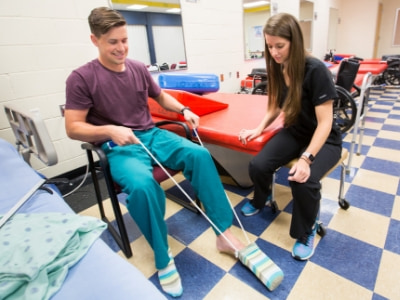About the Program
About Occupational Therapy
 Occupational therapy (OT) began as a profession in the United States in 1917 with the founding principle that everyday purposeful activities contain curative properties. At its inception, occupational therapy had a prominent role in the treatment of epidemics, mental illness and with children with disabilities. With changes in medicine and societal influences, OT developed a larger role in the treatment of physical dysfunction.
Occupational therapy (OT) began as a profession in the United States in 1917 with the founding principle that everyday purposeful activities contain curative properties. At its inception, occupational therapy had a prominent role in the treatment of epidemics, mental illness and with children with disabilities. With changes in medicine and societal influences, OT developed a larger role in the treatment of physical dysfunction.
Initially, registered occupational therapists (OTR) held a bachelor's (BS) degree. In 2007, all OTRs entering practice were required to hold a master's (MOT) degree. In a 2014 position statement from the Board of Directors of the American Occupational Therapy Association (AOTA), the Board recommended that “the profession should take action to transition toward a doctoral-level single point of entry for occupational therapists, with a target date of 2025.”
Today, OT practice includes areas across the lifespan - from neonates to geriatrics in both psychosocial and physical dysfunction. In addition to direct client engagement in therapeutic activities, services may consist of comprehensive evaluations of the client's home and other environments (e.g., workplace, school), recommendations for adaptive equipment and training in its use, and guidance and education for family members and caregivers. Since there are two levels of practitioners in the field of occupational therapy (the OT and the OT Assistant), it is common for occupational therapists to have supervisory duties over occupational therapy assistants in addition to direct client care.
Occupational therapy is unique in that it utilizes occupations - the familiar activities of everyday life - as a means of intervention. This necessitates a holistic and individualized perspective, including each client's psychological, cognitive, and contextual circumstances in addition to their physical condition.
Examples of occupational therapy intervention
- Enabling a child with special needs to maximize potential in school.
- Restoring physical skills lost as a result of a stroke, spinal cord injury or multiple sclerosis for improved independence.
- Making orthoses and adaptive devices for an injured worker to return to work.
- Teaching behavioral or coping strategies when trauma or disease disrupts completion of activities of daily life.
- Facilitating positive psychosocial skills for individuals with a variety of mental health needs.
- Recommending home modifications to enable an elder to continue living at home.
Employment opportunities are found in hospitals, rehabilitation centers, outpatient facilities, mental health programs, private practice, long-term care facilities, home health agencies, industry, school settings, and many other community based settings. The salary for starting occupational therapists varies from region to region in the United States. The most current information can be obtained at http://www.bls.gov/ooh/healthcare/occupational-therapists.htm.


